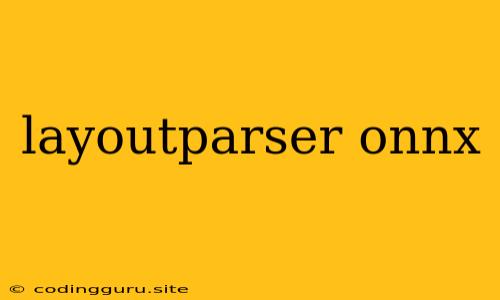LayoutParser: A Deep Dive into Efficient Document Understanding with ONNX
In the age of digital information, extracting meaningful insights from documents is a critical task. Whether it's processing invoices, analyzing contracts, or understanding scientific papers, the ability to accurately extract information from structured and unstructured documents is paramount. This is where LayoutParser comes in.
LayoutParser is a powerful open-source library designed to facilitate document understanding through layout analysis and information extraction. It leverages the capabilities of deep learning models, enabling it to comprehend the intricate layouts of various document types. At its core, LayoutParser provides tools to perform document segmentation, object detection, and text recognition, effectively laying the foundation for automated document processing.
What is ONNX and Why Does it Matter for LayoutParser?
ONNX (Open Neural Network Exchange) is an open standard for representing and exchanging deep learning models. It allows for seamless model interoperability between different frameworks, platforms, and devices. This portability is essential for LayoutParser, as it allows users to leverage a wide array of pre-trained models and deploy them efficiently on various hardware configurations.
How Does LayoutParser Work with ONNX?
LayoutParser utilizes ONNX models for both document layout analysis and text recognition. These models are pre-trained on large datasets of documents, enabling them to accurately detect and classify elements within a document's layout.
Here's a step-by-step breakdown of how LayoutParser integrates with ONNX:
- Model Loading: LayoutParser loads pre-trained ONNX models directly into its pipeline. This eliminates the need for complex model conversion steps, simplifying the integration process.
- Layout Analysis: The loaded ONNX model analyzes the document's layout, identifying key elements such as tables, figures, and text blocks.
- Object Detection: Object detection models within LayoutParser utilize ONNX for precise localization of objects within the document.
- Text Recognition: Text recognition models built on ONNX are employed to extract and recognize text from identified text blocks.
Advantages of Using ONNX with LayoutParser
- Improved Performance: ONNX models optimized for specific hardware configurations can deliver significant performance improvements, enabling faster processing and reduced latency.
- Enhanced Flexibility: The ability to utilize a diverse range of pre-trained ONNX models gives users flexibility in choosing models tailored to their specific document types and needs.
- Cross-Platform Compatibility: ONNX's platform independence allows LayoutParser applications to run seamlessly across different operating systems and devices.
Getting Started with LayoutParser and ONNX
The process of using LayoutParser with ONNX models is straightforward:
- Install LayoutParser: Install the library using pip:
pip install layoutparser - Load ONNX Model: Load the desired pre-trained ONNX model into the LayoutParser pipeline.
- Process Document: Pass the document to LayoutParser for analysis and information extraction.
- Extract Results: Retrieve the extracted data, including identified objects, recognized text, and layout information.
LayoutParser provides extensive documentation and examples to guide users through the process of integrating ONNX models into their document processing applications.
Real-World Use Cases
LayoutParser coupled with ONNX models finds applications in a multitude of domains:
- Invoice Processing: Automate invoice data extraction for faster accounting workflows.
- Contract Analysis: Extract key clauses and information from legal documents for efficient analysis.
- Scientific Paper Processing: Identify figures, tables, and references for research data management.
- Document Digitization: Convert scanned documents into structured digital formats, facilitating data archiving and retrieval.
Conclusion
LayoutParser, with its seamless integration of ONNX models, presents a powerful solution for addressing the growing demand for efficient and accurate document understanding. By harnessing the power of pre-trained deep learning models and benefiting from ONNX's interoperability, LayoutParser empowers developers to build sophisticated document processing applications with ease. The library's versatility, ease of use, and strong community support make it a valuable tool for developers and researchers seeking to unlock the information hidden within the vast sea of digital documents.
